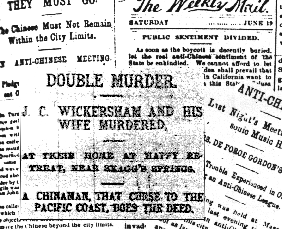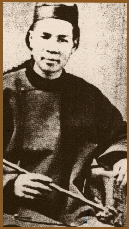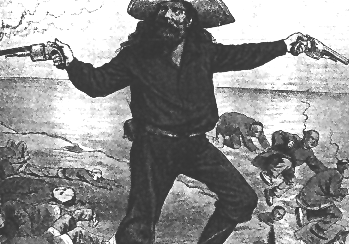Prime Suspect
by Simone Wilson

Northern California newspapers encouraged anti-Asian racism in the 1880's, particularly against Chinese


Prime Suspectby Simone Wilson
|
 Northern California newspapers encouraged anti-Asian racism in the 1880's, particularly against Chinese |
|
A Sonoma County
murder, committed at the height of anti-Chinese hysteria, inflamed racial tensions across California in 1886.
Not only did the crime furnish all the elements of a truly sensational mystery, it dovetailed with anti-immigrant passions similar to those today. Seizing on the lurid case, politicians and newspaper editors flung aside any pretense of objectivity and fanned the flames of ethnic hatred. When it came to inflammatory journalism, the National Inquirer and "Hard Copy" had nothing on California editors of the 1880's.
| |||
Bigotry seems to have rearranged the evidence |
The case involved
Jesse C. Wickersham and his wife, members of a prominent Petaluma family. There's still a Wickersham building in downtown Petaluma, built in 1910 on the site of Wickersham & Co., the first bank between Oregon and San Francisco. Jesse was the brother of Isaac G. Wickersham, president of the Petaluma National Gold Bank and one-time city council member. Jesse Wickersham was also a director of the bank; in 1880 he had bought a sheep ranch 28 miles northwest of Healdsburg, near today's Skaggs Springs Road.
Conflicting versions of the crime scene appeared in local papers over the next week. Some of the discrepancies can be put down to faulty memory, but bigotry seems to have rearranged the evidence retroactively. The first account of the murder, in the Jan. 23 edition of Santa Rosa's Sonoma Democrat, said Mrs. Wickersham's remains were found outside the house. Sheriff Bishop also told the Democrat reporter the couple's Chinese cook was rumored to have disappeared -- and was therefore a prime suspect. Two days later the other Santa Rosa paper, the Daily Republican, ran its story, and circumstances of the murder had altered considerably. Constable Truitt related that he found Mrs. Wickersham, "in a chamber bound with cords to the rails of the bed." Truitt freely describes the actions of "the Chinaman," including how he shot the couple and arranged the bodies, although there was no evidence of the cook's guilt so far except his absence from the scene. The cook, Ah Tai, had left his letters and money behind in his room -- proof, concluded the paper, "that the Chinaman in his flight did not stop to take any of his property." Later editions of the paper refined this story still further, asserting Mrs. Wickersham was found neatly laid out on the bed, with a piece of cake placed on her pillow in some sort of symbolic Chinese gesture -- supposedly further evidence of the cook's guilt. The presence of the gold watch was taken as proof that the object of the crime was not robbery, but rape. As for the stale slice of cake, it developed a life of its own and was cited repeatedly as a key piece of evidence in subsequent accounts of the crime. The Wickershams were buried in Petaluma on Jan. 25. The same day it was rumored the cook had been apprehended in San Francisco, and the Daily Republican announced that in Santa Rosa "lynching the brute was freely discussed" -- if, that is, the citizens of Petaluma didn't beat them to it.
| ||
Anti-Chinese associations and "anti-coolie" clubs sprang up all over the state |
 As so often
happens, prejudice against a minority -- in this case the Chinese -- had an economic basis. Thousands of Chinese came to California during the 1860's and 70's to work on the railroads. Once the tracks were laid, they stayed on in timbering, farming, cigar-making and household jobs. While times were good, white Californians co-existed amiably enough with Asian immigrants, but the late 1870's and 80's brought an economic downturn. White immigrants, most of them recent arrivals in California themselves, blamed the Chinese for their labor woes. Anti-Chinese clubs began forming in 1878. By 1885, disgruntled white workers clamored for the expulsion of California's quarter million Chinese, and politicians seized on the discontent as a hot issue. The sentiments in one Sonoma Democrat editorial are fairly typical:
As so often
happens, prejudice against a minority -- in this case the Chinese -- had an economic basis. Thousands of Chinese came to California during the 1860's and 70's to work on the railroads. Once the tracks were laid, they stayed on in timbering, farming, cigar-making and household jobs. While times were good, white Californians co-existed amiably enough with Asian immigrants, but the late 1870's and 80's brought an economic downturn. White immigrants, most of them recent arrivals in California themselves, blamed the Chinese for their labor woes. Anti-Chinese clubs began forming in 1878. By 1885, disgruntled white workers clamored for the expulsion of California's quarter million Chinese, and politicians seized on the discontent as a hot issue. The sentiments in one Sonoma Democrat editorial are fairly typical:
"Go where you may in the state you find swarms of these people," ran an editorial in Dec. 1885. "They are in every hotel, in nearly all private houses where servants are employed, in the laundries, in shops and stores, in the mines, on the farm -- in fact everywhere. The population of the state is about one million, one-fourth of whom are Chinamen. Now it is evident that Chinese immigration must be stopped or the ruin of California in inevitable." Anti-Chinese associations and "anti-coolie" clubs sprang up all over the state and as far north as Seattle. In January 1886 the Healdsburg Anti-Coolie Club secured signatures of 700 locals who pledged to withhold money from Chinese businesses, and Santa Rosans met at the town skating rink vowing to "rid themselves of the Chinese evil." The primary tool of expulsion was boycott. Chinese businesses were shunned; white employers were leaned on to fire Chinese staff. In Truckee, 300 Chinese who helped build the railroad that brought commerce to the town were fired. Boycott organizers repeatedly patted themselves on the back for pursuing non-violent tactics. The Democrat assured its readers that, "A movement has been started in Santa Rosa which proposed the sane, lawful and peaceable means of getting rid of the Chinese." Alarmed by the growing intolerance, the Chinese foreign minister asked U.S. Secretary of State T. Bayard early in Jan. 1886 to ensure the safety of his countrymen. California's Governor George Stoneman wrote in response,
"There is a deep seated and unanimous feeling on this coast against these people. The Chinese, owing to their gregarious habits, mode of living and the fact that they have no families to support, are crowding the Caucasian race out of many avenues of employment. Thousands of good citizens are unable to obtain a livelihood owing to this cause."
| ||
Local editorials on the heels of the murder reek of bias |
In this climate
of bigotry and self-righteous, news of the murders went off like a bomb, and inflammatory rhetoric reached new heights, or depths. Local editorials on the heels of the murder reek of bias. They also provide a textbook case of someone being tried and convicted in the papers. (FBI and attorneys of Atlanta Olympics guard Richard Jewell, please take note.)
J.W. Ragsdale, owner of the Daily Republican, fulminated, "The tragedy that occurred in the northwest portion of this county on Monday last, where two of our most highly respected citizens, man and wife, were murdered in cold blood by a Chinese fiend, has done much to increase the bitterness against a race that are most wicked and inhuman. It only proves the assertion that they have neither conscience, mercy or human feeling and think no more of murdering a human being than they do killing a pig. They are monsters in human form, cunning and educated therefore more dangerous and vile. Let us get rid of them and at once." A week later Thomas L. Thompson's Sonoma Democrat weighed in: "The sentiment against the Chinese runs high in consequence of this act of heathen brutality, and the Chinese during yesterday kept in close quarters," said the Jan. 30 Democrat -- not in an editorial but in the news story itself. "Chinese cooks will find great difficulty in securing employment in this section of the country hereafter." However, the Democrat's news story also introduced an intriguing element that was soon pushed aside in the general hysteria: "the theory that the deed was done by some one who purposely left evidence pointing toward the Chinaman as the perpetrator of the crime." In that case, continued the story, the real culprit also killed the hapless cook and hid his body to focus suspicion on him. The Democrat's editorial on the same day harbored no such doubts:
"Whatever fine spun theories may be invested to account for it, there is no doubt in our mind that the Chinaman, Ah Tai, who was employed in the family as a cook, and who disappeared as soon as the deed was committed, is the guilty wretch." Editors Thompson and Ragsdale both parlayed their staunch anti-immigrant stances into political gain. Thompson became California's Secretary of State and later a U.S. Congressman. Ragsdale was appointed U.S. Consul to Tientsin, China, proving that ignorance is no bar to political appointment.
| ||
The ending of the case bore an uncanny resemblance to the 1880 Marin tragedy |
In the wake
of the murder, anti-Chinese movements were further energized all over the state. Crowds turned out at mass meetings -- 2,000 in Petaluma, 1,000 in tiny Cloverdale near Skaggs Springs -- to press for a universal boycott of Chinese businesses. Lakeport organized an anti-Chinese club, and Santa Rosans circulated petitions not to patronize or employ Chinese after a March 1 deadline. In Cloverdale, northeast of Skaggs Springs, the Reveille reported in early Feb. that "the Hotel at Geysers Springs has discharged all its Chinese help." The trouble was reported as far away as Seattle and Victoria, where Chinese merchants organized soup kitchens for countrymen ousted from their jobs.
From here on the accounts become clouded. The Sonoma Democrat reported on Feb. 23, 1886 that U.S. detectives had captured Ah Tai in Yokohama and were waiting for government papers before returning him to the U.S. Perhaps the documentation fell through; perhaps he escaped. (Perhaps the man arrested was not Ah Tai at all.) At any rate, Ah Tai was reported arrested in Hong Kong a month later; accounts filtered across the Pacific that he had confessed his guilt to the Chinese quartermaster of the ship from Yokohama. No less an eminence than U.S. President Grover Cleveland signed papers requesting the British government at Hong Kong release the prisoner to American representatives. At the end of April a steamer from Hong Kong brought news to San Francisco that Ah Tai, while lodged in the city's Victoria Jail, had taken the cord from his draw-string pants and hanged himself in his cell. The ending of the case bore an uncanny resemblance to the 1880 Marin tragedy. Meanwhile, back in Petaluma, the city shut off the water supply to the Chinese quarter of town in March. Prominent ads appeared in the Cloverdale Reveille for the Cloverdale White Laundry, along with a item that "a Guerneville Chinaman has changed his name from Sing Lee to James Mahoney." By Spring, Chinatowns in numerous towns became ghost towns, although many homes and farms continued to quietly employ Chinese helpers. Around this time ranchers and other employers also began to foresee the downside of Chinese exclusion. Disgruntled ranchers complained there might not be enough white labor to get the harvest in. As summer approached and the crops ripened, anti-Chinese sentiment started to wilt in the hot California sun. Flamboyant speechifying dried up a little too. But a scan of today's headlines shows all too well that anti-immigrant rhetoric -- and the fears and prejudice that fuel it -- keep sprouting up like noxious weeds when times get hard.
 "You can go, or stay" Contemporary cartoon shows murderous attitude against Chinese immigrants |
Albion Monitor September 29, 1996 (http://www.monitor.net/monitor)
All Rights Reserved.
Contact rights@monitor.net for permission to reproduce.